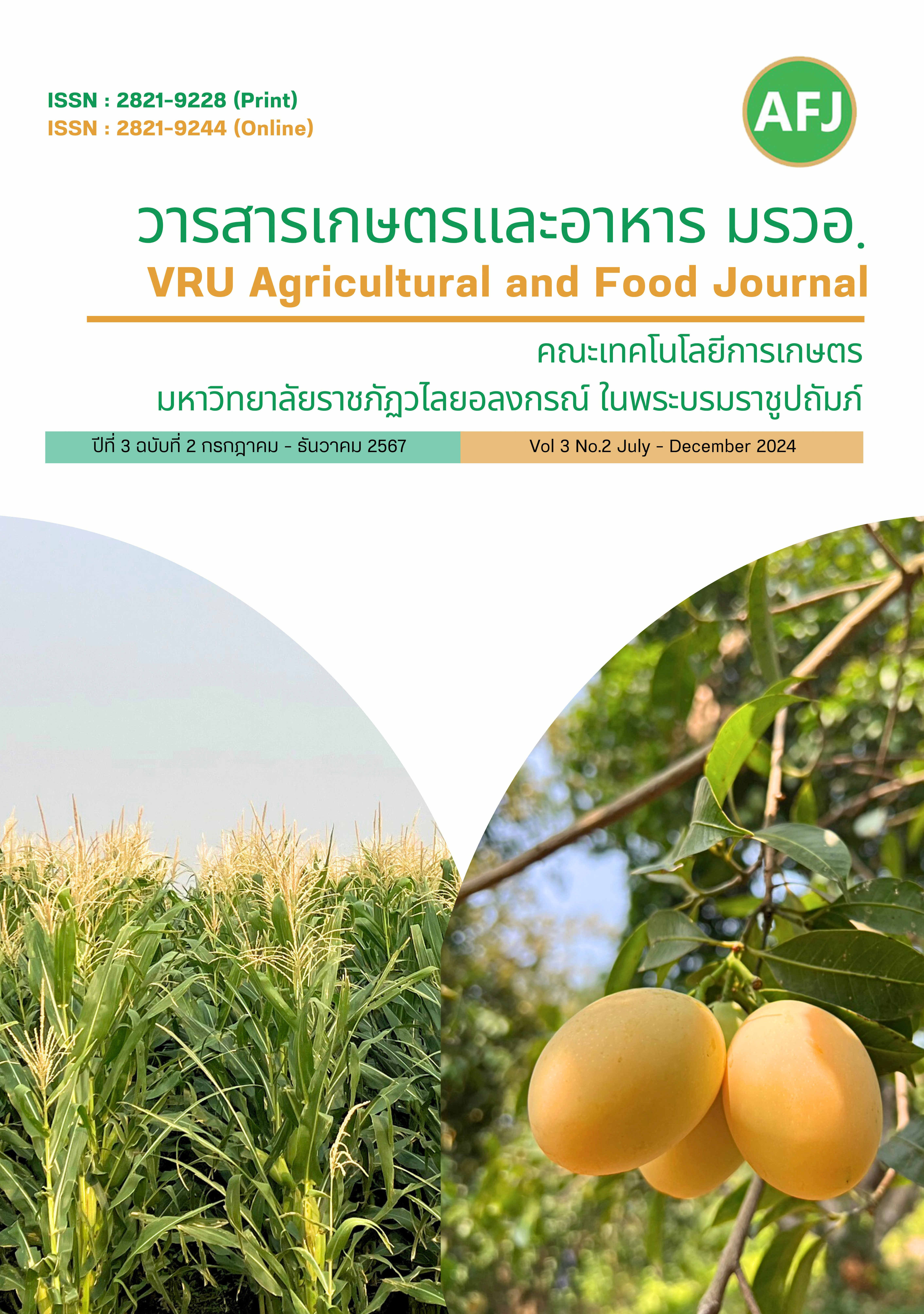การประเมินพันธุ์และอัตราปุ๋ยอินทรีย์ที่เหมาะสมในการผลิตมันสำปะหลังอินทรีย์
Main Article Content
บทคัดย่อ
การปลูกมันสำปะหลังในระบบอินทรีย์ เพื่อให้ได้ผลผลิตที่เหมาะสม และมีความคุ้มค่าทางเศรษฐกิจ จึงมีความจำเป็นต้องมีองค์ความรู้ด้านพันธุ์ และอัตราปุ๋ยอินทรีย์ที่เหมาะสม งานวิจัยนี้มีวัตถุประสงค์เพื่อประเมินพันธุ์มันสำปะหลัง และศึกษาอัตราปุ๋ยอินทรีย์ที่เหมาะสมต่อการปลูกมันสำปะหลังในระบบอินทรีย์ ทดสอบในแปลงปลูกพืชอินทรีย์ ศูนย์วิจัยพืชไร่อุบลราชธานี จังหวัดอุบลราชธานี ทั้งหมด 3 การทดลอง ได้แก่ 1).การประเมินพันธุ์มันสำปะหลังที่เหมาะสมต่อการปลูกในระบบอินทรีย์ วางแผนการทดลองแบบ RCB 7 กรรมวิธี จำนวน 3 ซ้ำ ได้แก่ มันสำปะหลังพันธุ์ระยอง 7 มันสำปะหลังพันธุ์ระยอง 72 มันสำปะหลังพันธุ์ระยอง 11 มันสำปะหลังพันธุ์ระยอง 86-13 มันสำปะหลังพันธุ์ระยอง 15 มันสำปะหลังพันธุ์ห้วยบง 60 และ มันสำปะหลังพันธุ์เกษตรศาสตร์ 50 2).ศึกษาอัตราปุ๋ยหมักเติมอากาศ และ 3).อัตราปุ๋ยมูลไก่แกลบที่เหมาะสมต่อการปลูกมันสำปะหลังในระบบอินทรีย์ วางแผนการทดลอง แบบ RCB 7 กรรมวิธี จำนวน 3 ซ้ำ ได้แก่ ไม่ใส่ปุ๋ยอินทรีย์ ใส่ปุ๋ยอินทรีย์อัตรา 6 9 12 15 18 และ 21 เท่าค่าวิเคราะห์ N ของปุ๋ยอินทรีย์ ผลการศึกษา พบว่า มันสำปะหลังพันธุ์ระยอง 11 เป็นพันธุ์ที่เหมาะสมในการปลูกในระบบอินทรีย์ สำหรับอัตราปุ๋ยหมักเติมอากาศ และปุ๋ยมูลไก่แกลบที่เหมาะสมต่อการปลูกมันสำปะหลัง ให้ผลผลิตแป้ง และผลตอบแทนทางเศรษฐกิจสูง คือการใช้ปุ๋ยหมักเติมอากาศ 21 (2,100 กก./ไร่) เท่าค่าวิเคราะห์ N เท่าค่าวิเคราะห์ปุ๋ยหมักเติมอากาศ และปุ๋ยมูลไก่แกลบ อัตรา 12 (1,200 กก./ไร่) เท่าค่าวิเคราะห์ N เท่าค่าวิเคราะห์ปุ๋ยมูลไก่แกลบ
Article Details

อนุญาตภายใต้เงื่อนไข Creative Commons Attribution-NonCommercial-NoDerivatives 4.0 International License.
บทความนี้ได้รับการเผยแพร่ภายใต้สัญญาอนุญาต Creative Commons Attribution-NonCommercial-NoDerivatives 4.0 International (CC BY-NC-ND 4.0) ซึ่งอนุญาตให้ผู้อื่นสามารถแชร์บทความได้โดยให้เครดิตผู้เขียนและห้ามนำไปใช้เพื่อการค้าหรือดัดแปลง หากต้องการใช้งานซ้ำในลักษณะอื่น ๆ หรือการเผยแพร่ซ้ำ จำเป็นต้องได้รับอนุญาตจากวารสารเอกสารอ้างอิง
Agbede, T.M., S.O. Ojeniyi and A.J. Adeye mo. 2008. Effect of poultry manure on soil physical and chemical properties, growth and grain yield of sorghum in southwest, Nigeria. Am. -Eurasian J. Sustain. Agric. 2: 72-77.
Agbim, N.N. 1985. Potential of cassava peels as soil amendment II. J. Environ. Qual. 14: 411-415.
Amanullah, M.M., S. Sekar and P.P. Muthukrish nan. 2010. Prospects and potential of poultry manure. Asian J. Plant Sci. 1-11.
Amonpon, W., S. Luanmanee, K. Paisancharoen, C. Pakddeethai, B. Srimungkun, P. Kalayasilapin, S. Tancharoen, S. Klongchang, A. Tiensiriroek, P. Muangsong, U. Wongchanapai, S. Thippayarugs, R. Boontung, P. Wongchanapai, A. Tippayawat, D. Kongthien, S. Phengkham, S. Sukto, J. Jarunate, T. Chuekittisak, V. Amonpon, K. Chusoon, M. Klomkaeww, M. Putkhao, C. Phruetthithep, N. Wannasai, P. Meunchang, N. Taweekul, S. Lapbanjop, R. Pratcharoenwanich, S. Bumrung, A. Summart, P. Jinjakarn, W. Chansrakoo, W. Nobuntou, W. Wannjak, R. Pansaita, A. Tongpoo, S. Auttajarusit, P. Namwong, K. Champathong, W. Thongmee and S. Boonpradup. 2015. Research and development on cassava cultural practice management. Department of agriculture. Bangkok. (in Thai)
Biratu, G. K., E. Elias, P. Ntawuruhunga and N. Nhamo. 2018. Effect of chicken manure application on cassava biomass and root yields in two agro-ecologies of Zambia. Agriculture. 8(45): 1-15. Doi:10.3390/agriculture8040045.
Department of Agriculture. 2023. System for inspecting and certifying organic plant production sources. Available Source: http://organic.doa.go.th/homepage, August 7, 2024. (in Thai)
Department of Land Development. 2023. Average amount of nutrients contained in animal manure. Available Source: https://osd101.ldd.go.th/q/manual/table_compost.pdf, August 7, 2024. (in Thai)
Klongtham, R., S. Anusontpornperm, S. Thanachit and I. Kheoruenromne. 2020. Cumulative effect of chicken manure, cassava starch manufacturing wastes and chemical fertilizer on cassava grown in Yasothon soil series. Khon Kaen Agriculture Journal. 48(6): 1292-1303. doi:10.14456/kaj.2020.114. (in Thai)
Komariah, K., M. Ito, J. Senge, T. Adomako and Afandi. 2008. Amendment of soil physical and biological properties using rice husk and tapioca wastes. J. Japanese Soc. Soil Phys. 108: 81-90.
Nilawong, V. 2018. Study on plant available nitrogen release in the soils applying different organic fertilizers. King Mongkut’s Agr. J. 36: 178-188. (in Thai)
Office of Agricultural Economics. 2023. Agricultural economic information by product. Available Source: https://www.oae.go.th/assets/portals/1/files/jounal/2565/commodity2564.pdf, July 30, 2024. (in Thai)
Okonkwo, C., I. Onyibe and C.N. Mbah. 2011. Influence of different forms of cassava peel on physicochemical properties of an Ultisol and yield of Maize (Zea mays L.) in Abakaliki south eastern Nigeria. J. Agric. Bio. Sci. 2: 78-83.
Shafeek, M.R., M. Omar. Nadia, R.A. Mahmad and M.M.H. Abd El-Baky. 2012. Effect of Bio- organic fertilization on growth and yield of cassava plants in newly cultivated land. Middle East J. Agric. Res. 1(1): 40-46.
Sok, S., I. Malik, J. Newby and K. Fahrney. 2018. Effect of fertilizer on growth and yield of cassava (Manihot esculenta Crantz). Available Source: https://research.aciar.gov.au/cassavavaluechains/wp-ontent/uploads/2018/01/Effect-of-Fertilizer-on-Growth-and-Yield-of-Cassava_SRIRJN.pdf, August 8, 2024.
Srimungkun, B., O. Wannawong, W. Prasomthong, and S. Chompoonukulrat. 2009. Annual reported 2010 of Ubon ratchathani field crop research center, Effects of nutrients on the amount of antioxidants in sesame (report P. 251-257). Ubon ratchathani, Thailand: Department of agriculture. (in Thai)
Vichukit, V., E. Sarobol, W. Lertmongkol, J. Jiamjumnanja, P. Changlek, P. Serivichayaswadi, P. Sarangrum, B. Phromsri, W. Kampanich, W. Sirichuaychoo and T. Aphauthaiphong. 2004. Suitable area management method for cassava growing in various soil types: Final report. Bangkok: Kasetsart University press. (in Thai)
Weil, R.R. and W. Kroontje. 1979. Physical con dition of Davidson clay loam after five years of poultry manure application. J. Environ. Qual. 8: 837-392.
Wongwiwatchai, C., K. Paisancharoen and J. Kokram. 2001. Soil fertility improvement through manures and cropping systems and the effect on cassava productivity in Thailand. Available Source: http://ciat-library.ciat.cgiar.org/articulos_ciat/proceedings_workshop_02/224.pdf, October 7, 2024. (in Thai)

